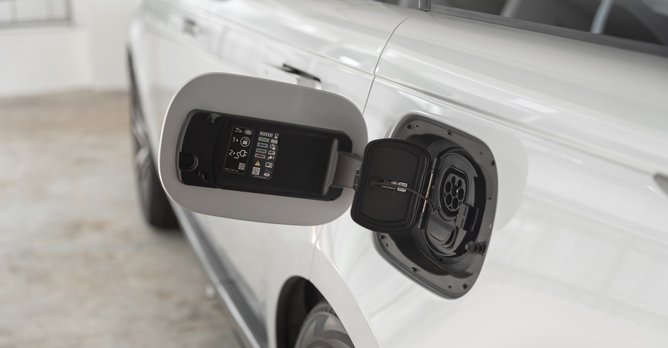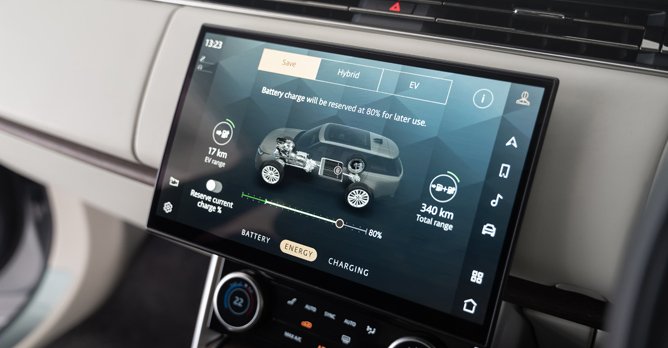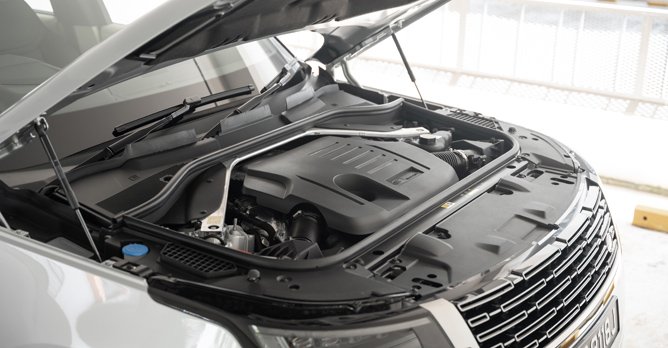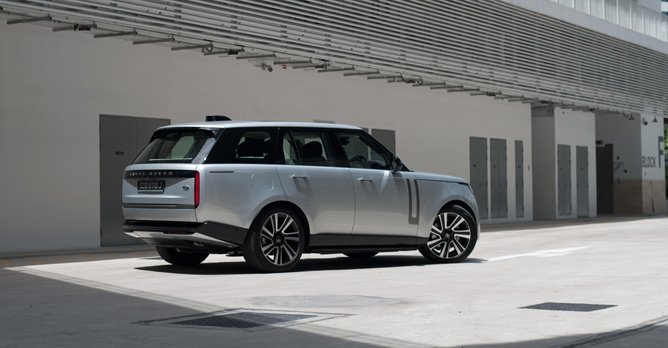Land Rover Range Rover Plug-in Hybrid 3.0 SE (A) Review
17 May 2023|5,262 views
What We Like
Usable range from 31.8kWh battery
Big and imperious, without absurd fuel economy
Easy to drive, despite its size
Cheaper than the equivalent mild hybrid option
What We Dislike
You'll hear the fans in action when the ventilated seats or rear air-conditioning is turned on
Press the button on the weighty key fob to open the tailgate of this Range Rover and the rear of the car elegantly splits into two, with both portions powered so they slowly pivot out of they way, all while the tonneau cover, also powered, folds aside to reveal the stored contents, or to make loading and unloading large items into the 1,050-litre boot easier.
It sums up perfectly what this Range Rover plug-in hybrid essentially is: Effortless.
Big and quiet

Take for example, the fact that it will get you from point A to B completely undisturbed. From behind the wheel, cabin insulation is so great that the air-conditioning and ventilated seat fans will be the primary sources of noise, even when you're travelling at speed.
Turn all these to a minimum and the occasional thump of the suspension working the wheels through obstacles will be the only company you get on your way to work.
And the ride quality is equally excellent. The Range Rover is always soft and pliant, even when driving over broken surfaces. Throw in the fact that there's commendable body control (impressive given this car's total 2,770kg weight), as well as the added agility from all-wheel steering, and the Range Rover marks itself out as a confidence-inspiring car to drive, even despite its 2,047mm width.
Strong and efficient

But that's not all that marks this variant out. This plug-in hybrid drivetrain also adds to the overall effortlessness when it comes to piloting the Range Rover.
With a total system output of 434bhp and with 620Nm of torque to deploy, this car feels genuinely spritely off the line despite all that weight. And even when you're up to speed, there's only a moment's delay as the eight-speed transmission finds a lower gear before you're whisked away on an electric car-like swell of uninterrupted torque.
All this means that commutes are always executed with ease, no matter the traffic situation.
And the Range Rover continues to behave as so even when the available charge from the lithium-ion battery is squirreled away or when it is completely flat. Driven as so, fuel consumption will dip to 6.8km/L, and you'll hear more of that 3.0-litre engine at work when pushing the car along.
Luxe and plush

Though it's still not quite enough to become a distraction when you're admiring the quality interior.
As in the Range Rover Sport, the 13.7-inch Interactive Drive Display comes with a host of personalisation options, so you can set it up to display all the information you want, or push all the clutter aside and get an easy-to-read navigation map.
Managing your available charge in the 31.8kWh battery is also easy thanks to the easy-to-understand controls all nestled within a sub-menu in the central 13.1-inch Pivi Pro infotainment screen.
I loved the round air-conditioning controls in the Range Rover Sport and found them an elegant and tactile alternative to having your climate controls hidden within the infotainment unit. However, with the frequent temperature and fan speed changes necessitated by the larger cabin and glass area of this Range Rover, the extra push/pull steps to adjust both fan speed and seat cooling can became a perturbing point.
Do it all
So, should you opt for the plug-in hybrid?
At $785,999 compared to the $793,999 asking price of the Range Rover in 'SE' trim equipped with a 3.0-litre mild hybrid drivetrain, the refinement and power offered from this plug-in hybrid ought to make it the first Range Rover you gravitate towards at the showroom, especially if (and I'm guessing it likely is) keeping that battery charged can be easily done at home (all prices as of 15 May 2023).
But this quick drive in this Range Rover plug-in hybrid has put into perspective for this storyteller just how fast the pace of electrification has been in recent years.
31.8kWh and 141bhp are the quoted figures for the usable battery capacity and electric motor output for this plug-in hybrid SUV, numbers which are close to what an all-electric car like the Hyundai Ioniq boasted just two years ago. And come 2024, the Range Rover lineup is going to get an additional all-electric option. Based on what we've seen Land Rover achieve today, that model just might be worth the additional wait for.
Looking for a large SUV? Don't miss our reviews of these other cars as well:
The Audi Q7 delivers on mile-crunching ability
The Mercedes-Benz GLE, meanwhile, offers high comfort and a well-appointed cabin
There's also this luxurious and efficient Lexus RX to consider
Or perhaps you might be swayed by this sleek Volvo XC90, also available as a plug-in hybrid
See more of just how luxurious this Range Rover is in our video review here as well!
What We Like
Usable range from 31.8kWh battery
Big and imperious, without absurd fuel economy
Easy to drive, despite its size
Cheaper than the equivalent mild hybrid option
What We Dislike
You'll hear the fans in action when the ventilated seats or rear air-conditioning is turned on
Press the button on the weighty key fob to open the tailgate of this Range Rover and the rear of the car elegantly splits into two, with both portions powered so they slowly pivot out of they way, all while the tonneau cover, also powered, folds aside to reveal the stored contents, or to make loading and unloading large items into the 1,050-litre boot easier.
It sums up perfectly what this Range Rover plug-in hybrid essentially is: Effortless.
Big and quiet

Take for example, the fact that it will get you from point A to B completely undisturbed. From behind the wheel, cabin insulation is so great that the air-conditioning and ventilated seat fans will be the primary sources of noise, even when you're travelling at speed.
Turn all these to a minimum and the occasional thump of the suspension working the wheels through obstacles will be the only company you get on your way to work.
And the ride quality is equally excellent. The Range Rover is always soft and pliant, even when driving over broken surfaces. Throw in the fact that there's commendable body control (impressive given this car's total 2,770kg weight), as well as the added agility from all-wheel steering, and the Range Rover marks itself out as a confidence-inspiring car to drive, even despite its 2,047mm width.
Strong and efficient

But that's not all that marks this variant out. This plug-in hybrid drivetrain also adds to the overall effortlessness when it comes to piloting the Range Rover.
With a total system output of 434bhp and with 620Nm of torque to deploy, this car feels genuinely spritely off the line despite all that weight. And even when you're up to speed, there's only a moment's delay as the eight-speed transmission finds a lower gear before you're whisked away on an electric car-like swell of uninterrupted torque.
All this means that commutes are always executed with ease, no matter the traffic situation.
And the Range Rover continues to behave as so even when the available charge from the lithium-ion battery is squirreled away or when it is completely flat. Driven as so, fuel consumption will dip to 6.8km/L, and you'll hear more of that 3.0-litre engine at work when pushing the car along.
Luxe and plush

Though it's still not quite enough to become a distraction when you're admiring the quality interior.
As in the Range Rover Sport, the 13.7-inch Interactive Drive Display comes with a host of personalisation options, so you can set it up to display all the information you want, or push all the clutter aside and get an easy-to-read navigation map.
Managing your available charge in the 31.8kWh battery is also easy thanks to the easy-to-understand controls all nestled within a sub-menu in the central 13.1-inch Pivi Pro infotainment screen.
I loved the round air-conditioning controls in the Range Rover Sport and found them an elegant and tactile alternative to having your climate controls hidden within the infotainment unit. However, with the frequent temperature and fan speed changes necessitated by the larger cabin and glass area of this Range Rover, the extra push/pull steps to adjust both fan speed and seat cooling can became a perturbing point.
Do it all
So, should you opt for the plug-in hybrid?
At $785,999 compared to the $793,999 asking price of the Range Rover in 'SE' trim equipped with a 3.0-litre mild hybrid drivetrain, the refinement and power offered from this plug-in hybrid ought to make it the first Range Rover you gravitate towards at the showroom, especially if (and I'm guessing it likely is) keeping that battery charged can be easily done at home (all prices as of 15 May 2023).
But this quick drive in this Range Rover plug-in hybrid has put into perspective for this storyteller just how fast the pace of electrification has been in recent years.
31.8kWh and 141bhp are the quoted figures for the usable battery capacity and electric motor output for this plug-in hybrid SUV, numbers which are close to what an all-electric car like the Hyundai Ioniq boasted just two years ago. And come 2024, the Range Rover lineup is going to get an additional all-electric option. Based on what we've seen Land Rover achieve today, that model just might be worth the additional wait for.
See more of just how luxurious this Range Rover is in our video review here as well!
Looking for a large SUV? Don't miss our reviews of these other cars as well:
The Audi Q7 delivers on mile-crunching ability
The Mercedes-Benz GLE, meanwhile, offers high comfort and a well-appointed cabin
There's also this luxurious and efficient Lexus RX to consider
Or perhaps you might be swayed by this sleek Volvo XC90, also available as a plug-in hybrid
Car Information
Land Rover Range Rover Plug-in Hybrid
CAT B|Petrol-Electric|58.8km/L
Horsepower
324kW (434 bhp)
Torque
620 Nm
Acceleration
6sec (0-100km /hr)
Thank You For Your Subscription.

































































